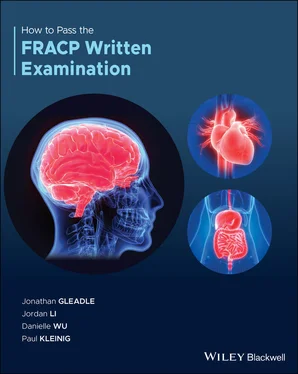
Burnett J, Hooper A. PCSK9 — A Journey to Cardiovascular Outcomes. New England Journal of Medicine. 2018;379(22):2161–2162.
https://www.nejm.org/doi/full/10.1056/NEJMe1813758
23. Answer: B
Long QT syndrome (LQT) is diagnosed by QT prolongation and T‐wave abnormalities on an ECG. A QT interval is measured from the onset of the QRS complex to the end of the T wave. The corrected QT interval (QTc, corrected for heart rate) can be calculated as QTc = QT interval + square root of the RR interval. The latest European Society of Cardiology guideline suggests upper limits of the QT interval of 480 ms on the ECG strip, regardless of gender. Presenting symptoms of LQT include dizziness, syncope, seizures, and in some cases cardiac arrest due to the presence of Torsades‐de‐Pointes which can degenerate to ventricular fibrillation causing sudden cardiac death. LQT can be congenital or acquired. LQT is associated with multiple risk factors, including a family history of LQT, ion channel abnormalities, structural heart disease, heart failure, advanced age, hypokalaemia, subarachnoid bleed, medications, diabetes, epilepsy, emotional stress, and physical stress, etc.
The aim of the treatment of LQT is to ensure patients are symptom free. The mainstay of management of LQT is beta blockers in both asymptomatic and symptomatic patients with LQT. Medication compliance is important to avoid life‐threatening consequences. Unfortunately, cardiac events cannot be completely prevented by taking beta blockers.
Life‐style modification such as avoiding strenuous exercises, emotional stress, physical stress, sleep disturbance, and medications that prolong the QT interval, should be implemented as much as possible.
ICD should be considered in symptomatic patients with syncope who are already on beta blockers, high risk patients with a very long QTc interval (> 550 ms), patients with T‐wave alternans, or in patients who cannot tolerate beta blocker therapy. If there are reversible causes of LQT, an ICD is not indicated.
Left cardiac sympathetic denervation (LCSD) is a rarely performed but effective procedure for management of LQT in patients who cannot have beta blockers or ICD. LCSD procedure involves high thoracic left sympathectomy and ablation of the lower half of the stellate ganglion along with T2 to T4. It reduces noradrenaline release at the ventricles and increase the threshold for ventricular fibrillation.

Shah S, Park K, Alweis R. Long QT Syndrome: A Comprehensive Review of the Literature and Current Evidence. Current Problems in Cardiology. 2019;44(3):92–106.
https://www.sciencedirect.com/science/article/abs/pii/S0146280618300513?via%3Dihub
24. Answer: D
This patient is likely to have a history of rheumatic fever leading to mixed mitral valve disease. She is symptomatic with pulmonary hypertension which is the indication for intervention. The mortality for untreated symptomatic severe mitral stenosis is 85% over 10 years. Complications for untreated severe mitral stenosis include endocarditis, atrial fibrillation, stroke, pulmonary hypertension, and right heart failure. The clinical features of severe mitral stenosis are:
Transmitral mean gradient >10 mmHg
Enlarged left atrium
Mitral valvular area <1.5cm2
Pulmonary hypertension.
In terms of intervention, percutaneous valvuloplasty should be considered if valve anatomy is amenable. Percutaneous valvuloplasty is less invasive and avoids anticoagulation which is an important consideration in an Aboriginal and Torres Strait Islander patient. Percutaneous valvuloplasty should not be performed in patient with moderate mitral regurgitation as the procedure will worsen mitral regurgitation. Recent emphasis on mitral valve conservation may lead to increased use of mitral valve open commissurotomy, wherein the surgeon, under direct vision, may be able to provide relief of obstruction in patients not suitable for balloon mitral valvuloplasty because of poor valve morphology. However, the percentage of patients that would likely have a bad outcome with balloon mitral valvuloplasty yet a good outcome with open commissurotomy is unknown but is probably small. When the valve can be conserved, it avoids the risks inherent to prosthetic valves and also avoids the need for anticoagulation for patients in sinus rhythm.
Putting these together, this patient has symptomatic, severe mitral stenosis with moderate mitral regurgitation and no other comorbidities therefore she should be considered for mitral valve replacement.

Carabello B. Modern Management of Mitral Stenosis. Circulation. 2005;112(3):432–437.
https://www.ahajournals.org/doi/10.1161/CIRCULATIONAHA.104.532498
25. Answer: D
Polyunsaturated fatty acids (PUFAs), such as omega‐3 and omega‐6 fatty acids, have multiple roles in membrane structure, lipid metabolism, coagulation, blood pressure, and inflammation. It has been suggested that regular supplementation of omega‐3 fatty acids is linked to a reduction in cardiovascular disease and other beneficial effects.
According to a recent Cochrane review, increasing PUFA intake may slightly reduce the risk of cardiovascular events but has no effect on all‐cause or cardiovascular disease mortality based on an extensive systematic review of RCTs conducted to date. The number need to treat to prevent one cardiovascular event is 63. The mechanism may be via serum triglycerides reduction.
Omega‐3 PUFA supplementation in type 2 diabetes lowers triglycerides and VLDL cholesterol, but may raise LDL cholesterol (although results were nonsignificant in subgroups) and has no statistically significant effect on glycaemic control or fasting insulin levels.
Omega‐3 fatty acids appear to have limited benefit in blood viscosity reduction in patients with intermittent claudication. However, there is no evidence of consistent improved clinical outcomes including quality of life, walking distance, ankle brachial pressure index, or angiographic findings. Supplementation may also cause adverse effects such as increased total and LDL cholesterol levels.
Direct evidence on the effect of omega‐3 PUFA on incident dementia is lacking. The available trials showed no benefit of omega‐3 PUFA supplementation on cognitive function in cognitively healthy older people.

Abdelhamid A, Martin N, Bridges C, et al. Polyunsaturated fatty acids for the primary and secondary prevention of cardiovascular disease. Cochrane Database of Systematic Reviews. 2018.
https://www.cochranelibrary.com/cdsr/doi/10.1002/14651858.CD012345.pub3/full
26. Answer: D
Treatment resistant hypertension is defined as persistent hypertension despite adherent and optimal therapy with three different classes of antihypertensive medication including a diuretic, or any four agents. Cardiovascular and renal risk for such patients is two‐ to six fold higher than for patients with controlled hypertension. Medication compliance is an important factor in evaluating this patient. In addition to screening for secondary causes, which should be guided by history, examination, and laboratory findings, guidelines now suggest addition of a mineralocorticoid receptor antagonist (MRA) for this patient group. This is a result of multiple studies showing significant benefit for MRAs in this patient population. It is suggested that this may be due to high levels of undiagnosed hyperaldosteronism, but the benefits of MRA therapy, while predicted by presence of hyperaldosteronism, are not limited to this sub‐population, and suggests of resistant hypertension is often indicative of a salt‐retaining state.
Читать дальше
















